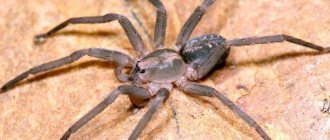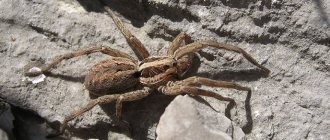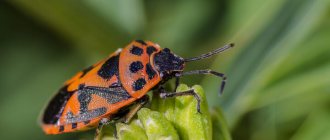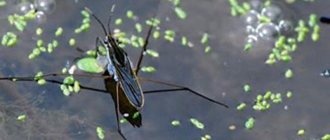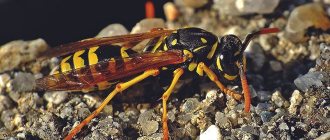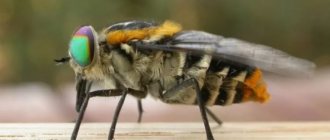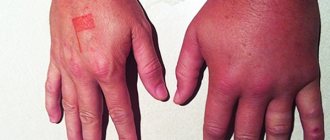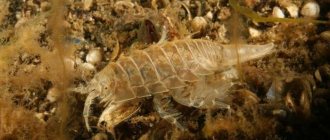What does a belostoma look like? Description of the insect
The insect reaches a length of 1-17 cm. There are different types of such pests, and therefore there are differences between them. The smallest individuals barely reach 1 cm, but they are rare.
Most often you can see in nature representatives with a length of 10 to 15 cm. Rare insects reach 17 cm.
Belostomas are aquatic, but breathe atmospheric air
. In addition to their impressive size, a number of other features of the appearance of these pests are noted:
- a hard shell, which prevents the insect from being injured when flying or falling;
- there are wings, and the front ones are more solid, and the rear ones are thin, transparent;
- the body is oval in shape, flattened, tapering towards the rear end;
- color is brown, and the shade can be different: it changes from light to darker.
- 3 pairs of limbs, they are located closer to the head, the front pair is more powerful, at the ends there are claw-like processes, thanks to which the insect quickly grabs the victim and holds it firmly;
- there are large eyes on the head, but the pest also navigates with the help of its senses.
Close-up photo: giant water bug
Belostoma is a useful predator, it should not be destroyed
Water bugs: smoothie, water strider, rower and belostomy
Bed bugs belong to the order Hemiptera; this family contains many different insects that live not only on land, but also in water. For example, in the tropical latitudes of America and the USA you can find huge water bugs. Their size reaches 15 cm in length!
This insect is a dangerous predator that attacks young fish, snakes, turtles and frogs.
The water bug looks terrifying: its large size, large forelimbs, curved in the form of ticks, cause horror. Water bugs can also be found in ponds in Russia, but, fortunately, smaller and less aggressive predators live in our latitudes.
Where does Belostoma live?
The name Indian bug is often heard, but this pest is found in many countries, not only in India. It lives in the Neotropics, Neoarctic, Africa, Asia. A warm or at least moderate climate is suitable for belostomy.
However, some individuals have taken root in areas where it is quite cold, for example, in the Far East.
Most insect species can fly, but they do not do it very often. The belostom bug is found in bodies of water with weak currents; it prefers wetlands, freshwater bodies of water, rivers, ponds, and streams.
Belostoma - a predatory insect
How to get rid
Very often, water bugs are found in home ponds and swimming pools. In the latter case, this causes particular inconvenience, since the bites cause the desire to swim to disappear, especially in children. Chlorinating the water will not help in this case.
Many people catch bedbugs using nets, but this is a temporary measure. Since they migrate, if there are other bodies of water nearby, they quickly fly back.
The solution, if the pool is small, is to cover it with a fine mesh during the period when no one is swimming. There are remedies for bedbugs, but they are not safe for humans, and they will have to be used constantly due to migration.
The water bug is a common, but not dangerous insect for humans. It feeds on other smaller ones, including mosquitoes, occupying an important position in the food chain. When visiting bodies of water, it is better not to touch them to prevent being bitten. They pose a danger only to people prone to allergic reactions, which is rare.
Lifestyle
Insects of this species are very unusual.
They are aquatic, but breathe atmospheric air. Their body structure allows them to combine such capabilities. So, the belostomy has a breathing tube. The insect can completely draw it into itself. When the need for air arises, the giant water bug raises the back of its body above the water. Using an elongated tube, the insect receives a portion of air, which allows it to descend again to the bottom of the reservoir where hunting is carried out.
Belostoma is a predatory insect. This means that the bug attacks other creatures and does not feed on plants. But such a pest feels free near smaller prey. If a predator finds itself close to a large creature, a natural enemy, or senses danger, it immediately pretends to be dead. Outwardly, it can be mistaken for last year’s rotten leaf. This is facilitated by the color of the insect, as well as the shape of the body and the pattern on the body, which is formed due to the folded wings.
Belostoma does not consider humans as food
Migration of pests of this species occurs in cases where the amount of food decreases.
Then the belostoma water bug uses its wings to move to another area where there is a body of water. Moreover, there are no difficulties in this case. This predator, although heavy, rises freely into the air. Its wings are large enough to support the bedbug’s own weight. Belostoma does not remain in the reservoir forever. The bug has the habit of spending the winter on land. To do this, he climbs into hidden places: cracks in stumps, under the bark. This opportunity appears due to the flattened body of the pest.
Hard outer integuments are not injured in this case, since the outer integuments are quite strong. These insects also feel free in water. They can swim. This possibility is provided by the presence of hairs on the limbs. The significant length of the legs also facilitates movement under water. When the pest is busy hunting prey, it sits motionless on plants and stones. In the water column, giant bugs are invisible due to these features.
Giant water bug eats a frog
Types of water bugs
The four most common families in the world are:
- water strider;
- smoothie;
- rower;
- Belostoma.
Each of these types has its own unique characteristics.
Water strider bug
Water striders stand out among their group in their mode of movement and hunting. These insects do not dive into the depths of water, but spend the active period of their life on its surface.
The body shape of water striders is thin and highly elongated. Like all insects, it has three pairs of legs. The two rear pairs of legs are adapted for moving on the surface of the water. The insect's low weight and large support area do not allow it to break through the surface tension film of the liquid. Pushing off the surface with its feet, the water strider glides through the water. The front paws are used to hold food. The water strider feeds on floating microscopic inhabitants of the reservoir and other insects that fall into the water. Food is not found very often, so water striders have to move around a lot in search of food.
Hidden under the hard elytra are transparent wings, which water striders use very reluctantly. Flights occur only when unfavorable conditions occur in the native body of water and over short distances. Once on land, the water strider does not stop moving, but only slows down significantly.
Smooth water bug
This insect has a boat-like body. The way it moves is original and further enhances its resemblance to this ship. When immersed in water, the smoothie turns over with its belly up and begins to work hard with its hind paws-oars. At the same time, huge eyes allow you to observe the upper layers of water in search of prey. Noticing the victim, the smoothie rushes headlong at it. The main diet of smoothies consists of small underwater animals and their larvae.
The airy film, which adheres to the hairs that densely cover the entire body, helps the smoothie stay under water for a long time. The smoothie gets the necessary supply of air by floating to the surface and exposing the back of its body to the atmosphere.
The wings of the smoothie are highly developed and allow it to make long flights. He often uses this in search of water bodies richer in food. Gladfish can live not only in large ponds, but also in small puddles and even in barrels of water. If there is not enough prey, the bug leaves the hunting grounds and looks for a new place. Prefers to travel at night.
Streaked water bug
From a distance, the paddlefish can be mistaken for a smoothfish due to its swimming method. The locomotor system of the rower consists of two powerful legs ending in large area of hair-cilia. However, he prefers to move in the usual manner - with his back up. To replenish the supply of air, it floats to the surface and accumulates atmosphere under the elytra. A large air bubble pushes the body up, and it has to be held on by the leaves and stems of aquatic plants to prevent it from floating up.
The paddlefish is similar to its terrestrial relatives in the presence of scent glands. The secretions from them scare off potential enemies. At the same time, the smell helps to attract individuals of the opposite sex.
The peculiarity of the rower is that it also “sings”. The sound is made by rubbing the front paws on the proboscis. In nature, people can very rarely hear a rowing sound, since the sound strength is very small, and it also comes from under the water. Some people keep these bugs in aquariums with fish, and in the silence of the apartment you can hear the quiet “voice” of the bug.
Belostoma - a giant water bug
The name itself speaks volumes about the size of the insect. If most of its relatives have a body length of 1-2 cm, then the Belostoma grows into a 10-centimeter giant. For life, it prefers to choose shallow reservoirs with very warm water. Therefore, belostomas (swordsworts) are widespread, mainly in the tropics. Although there are species that have adapted to lower temperatures and have colonized the Far East.
Belostoma is nocturnal. It attacks its prey from ambush, infecting it with a nerve agent. Careless frogs, small fish and miniature turtles become victims of the predator. He attacks fauna not only smaller than himself, he is not afraid to choose larger specimens as victims. In some countries he even received the nickname “fish killer”.
The strongly developed front legs are equipped with large hooks that help to hold caught prey. The shape of the "combat" limbs resembles the claw of crabs or, rather, the front legs of a praying mantis. Like the others, it has wings, but flies only when necessary.
Belostoma nutrition
Such insects choose victims that are smaller in size than themselves. These could be turtles, fish, frogs. Moreover, for insects it does not matter whether the prey is small (like fry) or larger. Sometimes giant water bugs choose as food the inhabitants of reservoirs that are much larger than the predator itself.
Free choice of food source is determined by dietary characteristics.
Belostoma is a predator, can eat snakes.
Thus, Belostoma digests food even before it enters the digestive tract. This is due to the fact that the bug introduces a special substance into the body of the potential victim - an enzyme. It is thanks to him that the process of digesting food begins even before it ends up in the body of the pest. In this case, the victim herself quickly dies. The tissues of her body decompose and turn into a liquid substance. Belostoma patiently waits for “lunch” to be ready. After some time the bug gets
ability to suck out nutritional fluid. When someone meets such a predator and learns about its feeding habits (the insect eats turtles and snakes), a picture appears before one’s eyes of how the insect eats crustaceans and amphibians whole. In fact, the bug does not have the ability to make a full bite; it has a piercing-sucking type of mouthparts. This allows the pest to puncture the body of a potential victim.
The insect then literally sucks all the juices out of the creature that has become food.
Close-up photo: Belostoma eats a snake
Belostoma eats a snake
Close-up photo: Belostoma feeding on a turtle
Belostoma can kill a turtle
Close-up photo: eating a frog
Belostoma is a predator among insects
Nutrition
All water bugs are predators. Their prey includes small insects, fry, fish eggs, larvae, and frogs. An elastic proboscis allows one to inject poison that has paralytic properties into the victim’s body and suck out biological fluid from it without resistance. Some varieties of bedbugs inject saliva into the caught prey, liquefying the insides, and then suck out the resulting juice, leaving only the shell.
Nutrition
If there is a lack of food, bedbugs can eat each other.
Main features of Belostoma propagation
To mate, the female is active - she is the one who is interested in finding a male. This is due to the fact that the bugs of this species have switched roles. Thus, the male takes great care of the offspring. The female's task is to lay eggs. Moreover, for this she chooses the most unexpected places. Individuals of other species lay eggs on the surface of aquatic vegetation. Others use their brothers for this.
Thus, females can lay eggs on the back of the male.
Belostoma bugs have changed places: the male takes care of the offspring.
The lifestyle of Belostoma is only slightly different from the habitat of other insects. Otherwise, the pests converge with each other. For example, they note the possibility of attracting a partner for mating. For this, special enzymes are used. Other insects react to them thanks to their sense organs.
The breeding season for giant water bugs begins in the spring. Moreover, the female lays eggs in several approaches. The back of the male is a reliable shelter for the offspring. But as insects move, the risk of damage or loss of eggs increases. To prevent the offspring from being carried away by the current, female bugs secrete a special secretion that firmly “glues” the eggs to the back of the male.
After the larvae appear, the male bug dies
Caring daddies
The water bug behaves like a real parent:
- pumps the water, performs this movement with its paws, which helps to increase the oxygen content, because the circulation of fluid improves, and the male knows exactly when it needs to be done, which sometimes makes him a better parent than the female, who does not participate in any way in bearing the offspring ;
- the male periodically rises to the surface of the water, he does this in order to protect the offspring from the fungus: when the eggs are warmed by the sun, ultraviolet light provides a disinfecting effect, thanks to this all microorganisms die, which is an important stage in bearing offspring, since there are quite a lot of eggs - there are up to 100 pieces, which means they are tightly spaced;
- a water bug with eggs on its back hides until the larvae appear, it does this to keep them from danger, because during a fight with an enemy, a potential victim, there is a risk of injuring the offspring, as a result, the insect does not hunt during the gestation process larvae inside protective shells.
The male does not mate during this period. Despite increased care, it dies as soon as the larvae appear.
Birth of larvae from Belostoma eggs
Breeding
Belostomas demonstrate paternal care. These aspects have been extensively studied, including with the North American flumineum and the East Asian summerweed (Kirkaldyia) deyrollei. The eggs are usually laid on the wings of the male and carried by him until hatching.
The male cannot mate during this period and spends a lot of time and energy on reproduction. Females play an active role in searching for males to mate with. In the subfamily Lethocerinae, eggs are laid on emerging vegetation and are guarded by the male.
Is belostoma dangerous for humans?
Insects of this species live at the bottom of reservoirs and also travel by air. This increases the likelihood of meeting them. The risk of contact with belostomy is also high due to the inconspicuous appearance of the insect - the brown color does not allow the pest to be recognized at the bottom of the reservoir. Accordingly, a person sometimes encounters such a bug.
The predator itself does not consider humans as a source of food. Belostoma injects a small amount of nerve-paralytic poison into the body of its victim (turtle, fry, snake). It is impossible to hit a person with it. However, the pest still sometimes bites people. This happens if the bug suddenly senses danger. Then he attacks.
A Belostoma bite can take about three weeks to heal.
The harm that water bugs can cause to people
During contact with an insect, severe pain occurs. All people who have had to deal with the pest talk about this. But the unpleasant sensations pass quickly enough, which cannot be said about other symptoms of a bite. When a bug attacks, a certain amount of poison still enters the human body. This affects the healing rate of injured tissue.
As a result, the bite lasts longer than after contact with other insects - this may take 2-3 weeks. They also note the risk of developing allergies, which is influenced by the degree of sensitivity of a person. Most often, a red spot remains, and it is darker in the center. Sometimes there is a local increase in temperature, which is due to the development of the inflammatory process. Itching also appears.
In this case, treatment should be symptomatic.
Photo: what threatens the bite of a giant water bug
A belostoma bite can become inflamed and take a long time to heal
What symptoms should you consult a doctor for?
Despite the fact that the bite takes a long time to heal, you need to control this process. If after 2-3 weeks the skin is still inflamed, painful, the red spot does not decrease, or pus appears, you should consult a doctor. These may be signs of infection.
In severe cases, it is necessary to open the abscess and wash the wound.
Belostoma can attack a person if it senses danger
Bed bug
Quite well-known bed bugs are their oblong-shaped body, which grows up to 8.5 mm. Mature individuals are red-brown in color, while their larvae are white. They are the owners of the very glands from which the unpleasant odor emanates. Bedbugs prefer to settle in houses, closer to people; bat nests and mouse holes are suitable for them.
In warm conditions, bloodsuckers can reproduce around the clock. A female bedbug lays about 10 eggs per day, and over the course of her life she can produce up to 260 eggs. The larva from the egg is born after 17 days.
When the air temperature drops to +10 °C, insects will be able to live for six months without food, and their larvae will enter suspended animation and can remain there for up to a year. In frosts with temperatures below -17 °C, bedbugs can live no more than a day, and in heat above +45 °C they will die out within half an hour.
Every bug is needed by nature, although not all people understand this. Of course, there are dangerous representatives, but if you look after your home and carefully choose places for swimming, then nothing terrible will happen. Each type of bedbug is of particular value to other living organisms and nature as a whole. They are part of the food chain, so their extinction could lead to the death of several species of diverse fauna and flora.
For some people, the bug is associated with a domestic bloodsucker, while others think of it as an agricultural pest that spoils grain crops. But our planet is inhabited by a huge variety of arthropods from different families, distinguished by their unique body structure and habitat.
Who are the belostomatidae swordsworts, they are also giant bugs
This is the name of one of the types of belostoma. They are large, and in their lifestyle they are not much different from the rest of their brothers. The principle of reproduction is the same - laying is done on the back of the male. Insects have the ability to fly; they do not die in winter, but remain on land and hibernate.
The emergence of a new species of insect of the belostomatidae family – the swordswort
The swordfish is believed to be a recently discovered species of waterfish. In fact, such insects have been known for a long time. If you still see headlines like this today, you shouldn't take them seriously. It's more like drawing attention to less interesting content.
Belostomas overwinter on land, hibernating
How to recognize an insect
General characteristics:
- Typically the body length can be about 15 mm;
- Waterbugs can bite and emit unpleasant odors;
- The insect has elytra, so it can easily fly;
- The bite most often occurs on the fingers and toes and is quite painful;
- Water bugs are predatory insects;
- They breathe through tubes that are located on the abdomen, so they constantly float up for the next portion of air.
The most common and numerous are smoothies. Their body size can exceed 14 mm. The thoracic region can be traced between the abdomen and head.
On their head they have eyes that have a reddish tint. The insect feeds in a piercing, sucking manner through the proboscis adjacent to the abdomen. This organ is cruel enough to pierce human skin and reach blood vessels. The bite is immediately felt because it hurts. Because of this feature, the smoothie is called the “water wasp.”
This insect takes on its color from the water in the place where it lives. Color can vary from dark green to brownish-brown. Sometimes there are bright yellow and even pink individuals. If you look closely, its back and elytra are slightly lighter than its belly.
There are 6 legs on the chest. The back pair of legs is slightly longer and stronger, since it is on them that the emphasis is placed when moving through the water. Dense bristles grow on them. When getting out onto land, the bug in question moves with difficulty - its front legs cling to uneven surfaces and pull up its body.
The four-segment abdomen is covered on the dorsal side by elytra. The upper part of the body is slightly curved, and there is a thickening on the abdomen.
There is no need to specifically touch the insect; this will result in an immediate bite.
Due to the fact that the smoothie inhales atmospheric air, its body has positive buoyancy. The spiracles are located on his chest. There are 10 pairs in total. Thanks to their movement, the trocheal trunks open. Under the elytra there are stigmata on the chest, which open into special hermetically sealed chambers. Air channels from the surface of the abdomen are also supplied there. They are hidden under 4 stripes of hairs. The bug has a main respiratory site, which is visible in the 7th segment of the abdominal part of the body. It is covered with thin hairs. Some of them may move. When the hairs close together, they close the opening of the breathing hole.
This type of bugs, like bobcats, live in latitudes with a temperate or northern climate. They are a little larger than smoothies by a couple of millimeters. Unlike them, they move through the water with their backs up. They can rotate and tilt their head. It has a trunk, which cannot be seen at first glance - it is located under the lip. Males differ from females in the structure of the front pair of legs; they have small tubercles that help them make chirping sounds.
Observing these arthropods in stagnant bodies of water, you can notice their ability to fly out of the water in a matter of seconds.
Unlike their relatives, paddlefish do not have a proboscis with which they could pierce the food source and get enough. They eat by opening their mouths and pushing food into them with their front paws. In the cold months, they do not hibernate, but continue their active life.
Important! If you do not touch the bug, it will not attack with the aim of biting.
Some varieties of bedbugs, such as the pest bug, the Italian stink bug and the stink bug, leave a specific odor when they fall into human hands.
They should be handled with extreme caution
The water strider bug poses no threat
. They do not avoid people, so you can meet them everywhere during the bathing procedure. In case of a bite (for protection purposes), do not be alarmed, but treat the wound with any antiseptic as soon as possible.
If you meet a water strider in hot countries, then prepare for the fact that the bite will be painful for some time after it, and the area around it may become numb. If you have allergies, be sure to take antihistamines.
White mastids are excellent swimmers. Nature has endowed the front pair of paws with hooks, with which they catch their prey and do not let go even when it moves.
Belostoma - an exotic delicacy
In Asia (some regions) these insects are eaten. They taste differently. Some people believe that bedbugs have specific taste qualities. Others claim that they resemble chicken and shrimp. But local residents usually eat such food; not all Europeans or tourists from other countries risk trying the predator.
Interesting photo: fried bugs of the family Belostomatidae
Fried Belostoma
Signs of a bite and first aid
Pain, swelling, redness and itching are attributes of an insect bite. The reaction occurs as a result of an allergy to enzymes introduced by the bug. Of course, these signs will manifest themselves differently in different people. It depends on the body’s predisposition to allergies. Belostoma bite
Of course, the first thing you need to do if you are bitten by a water bug - belostoma, gladysh, plavt or water scorpion - pull yourself together and remember that these are not poisonous insects.
And then you must definitely do the following:
- Wash the bite site with running water and soap;
- Apply cold to the wound. If there is no ice at hand, press the sore spot with your finger or apply a pressure bandage above - these actions will prevent the spread of allergens;
- To avoid bacterial or viral infection, treat the wound with any disinfectant: ethyl alcohol, iodine, chlorhexidine, miramistin, etc.
To reduce pain and swelling, use Boro Plus ointment or Fenistil gel.
From “grandmother’s” remedies, you can use soda lotions, tinctures of calendula or Corvalol applied to the wound. Tea tree essential oil helps: a few drops will relieve itching and disinfect the bite site.
Many of us have been bitten by mosquitoes and ants, stung by wasps, bees and horse flies. “It went away on its own.”
If you have a strong body and good immunity, these measures can be limited: your body itself will cope with the consequences of the bite.
Bedbug is a favorite delicacy of some peoples
The water bug is prepared in different ways:
- by drying;
- frying method.
In both cases, insects are not crushed. They are consumed in dry form, and belostoma is a kind of snack that they chew on.
This food is used as a snack; it can be bought at street food outlets.
In Asia, belostoma is a delicacy.
In addition, insect glands located in the anus are used. They are used instead of spices to give a specific taste to dishes.
Is the water bug dangerous for humans?
There is no immediate danger to humans . Due to the huge difference in size, insects living in water do not consider humans as prey. All the usual victims have different sizes and habitats.
Waterbugs should not be considered completely harmless insects. In case of danger, the insect bites. For this, for example, the smoothie received the nickname water bee (water wasp) in Germany. In most cases, the bug simply pretends to be dead. The water scorpion reacts in the same way; if you don’t touch it, then there’s nothing to be afraid of.
Implications for the ecological system
The water bug helps control the number of many pests, including snakes, three-keeled turtles, and some insects, because they destroy beneficial creatures. For example, the three-keeled turtle feeds on fish and other aquatic inhabitants. To prevent some species from becoming extinct, predators such as the belostoma destroy the natural enemies of many other creatures. They live where there is enough food.
Belostoma is included in the Red Book due to mass destruction by Asians as food
Are bites dangerous?
If you accidentally touch a bug while swimming, it may consider this a threat, and then a bite cannot be avoided. Water striders, smoothies and rowers are common in Russia, and only the bite of a smoothie can cause discomfort.
When an insect bites, it injects protein, so the wound does not heal for a long time.
The damaged area will swell, turn red and itch. To speed up healing, it can be treated with brilliant green. To relieve itching, various ointments for mosquito bites are suitable. The poison only causes pain, but in fact does not bring any harm to a person. A waterbug bite also does not transmit any infections.
Reviews
Larisa, 38 years old, Krasnoyarsk
I once met a big beetle, I was just walking, and it flew into me. I saw it when it ended up on the sleeve of my clothes. She got scared, waved her hand, and he immediately disappeared. For a long time I couldn’t figure out who it was. Recently, quite by accident, I came across information about such insects. It turned out that it was a belostoma, it was looking for a place to live when I met it.
Olga, 32 years old, Moscow
I was once bitten by something in the water. We were swimming in the river, I stepped on the bottom, then I felt severe pain. Then my husband showed me who I had crushed - he took out this bug. It was shallow there.
Anna, 36 years old, Saratov
I have seen a bug kill a frog. It was like versus (battle). I didn’t know then that these bugs feed on frogs and even turtles. Although the insect is large, it is still not strong enough, as I thought, but I was wrong.
Due to its color and body shape, Belostoma is invisible on rocks and in the water column
Insect habitats
Most species of water bugs live in fresh water bodies at considerable depth. However, they cannot breathe underwater; they have special air sacs, which they replenish when floating to the surface.
Belostomas live in tropical regions and some areas of North America. They are most common in the USA, South Africa, China, Thailand, India, Brazil and Argentina. Other species live almost everywhere.
Danger to humans
Do not be afraid of large insects; water bugs do not pose a danger to humans. This is due to the fact that they compare the parameters of the intended prey with their own and will not risk rushing at such a large predator. However, if the insect senses danger, it may bite.
This often happens to children because of their natural tendency to be overly curious. After a bite, water bugs inject an enzyme that prevents the wound from healing quickly. This causes the bite to remain for several days or even a week. In rare cases, an allergic reaction of varying severity is possible.
More discomfort is caused by the bites of bedbugs that live in tropical waters. The most painful are smoothies. The damage can be compared to a bee or wasp sting. Swelling of the injured limb, numbness and pain may occur.
There are varieties of bedbugs that, upon contact, leave a strong, unpleasant odor on the limbs. These include:
- stink bug;
- Italian shieldweed;
- bug harmful turtle.
Expert opinions
Petrova Irina Igorevna, entomologist, 24 years of work experience:
Petrova Irina Igorevna
Entomologist with 24 years of experience
Ask a Question
• the back at the time of bearing offspring is a vulnerable place, therefore, when a threat appears, the bug can bite the attacker, but at this time it does not bite unnecessarily; • belostomy is found not only in stagnant water (swamps, ponds), but also in rivers if the current is weak, so there is a risk of biting a person who comes to swim; • there is no need to destroy the white stump, even if it has bitten you, because it is a useful predator, it is better to draw conclusions from the situation, try not to step on the bottom, avoid old stumps and trees before the onset of winter, because this is where bedbugs look for shelter.
Belostoma males are directly involved in raising offspring
Gladysh bug or water wasp
The main feature of the smoothie bug is its method of movement through water. Pushing off with its hind legs, it strokes the surface of the lake, quickly covering long distances. A favorable habitat is standing water, a pond or a lake. Sometimes smoothies can be seen not only on a pond, but also near the house, because he is attracted to night lights. On the back there are two pairs of transparent wings and elytra. Hunger forces the insect to rise into the air when the food supply in the next pond runs out.
Gladysh is an excellent hunter and master of camouflage. When immersed in water, it floats belly up, thanks to which it has the opportunity to control a significant area of the reservoir. The insect's back in the water makes it invisible to fish. Having caught prey, the smoothie sprays it with a special enzyme, then pierces it and sucks out the internal contents.
Rubbing its proboscis with its feet, it makes sounds that resemble the chirping of a grasshopper. Smooth water bugs do not harm humans; they can only sting when picked up.
Are they dangerous to humans?
Water bugs do not pose any danger to people . If an insect bites a person, it will be nothing more than just protection. If a person approaches an insect, it can pretend to be dead or can scare away a potential enemy by throwing out its odorous secretion on him.
Water bugs migrate in the spring, seeking out new water reservoirs. This is why huge flocks of smoothies can stumble upon people. Since their flight speed is very high, such collisions are very unpleasant.
Gastronomic delicacy
In Vietnam, giant bugs are a very valuable resource. There, liquid is collected from the males from the pheromone-producing sacs. Ca'Cuong is the name of the product that has already entered the world market. One drop of this substrate changes the taste of the dish and, according to the Vietnamese, has a very beneficial effect on... you know what.
In Thailand, these insects are simply fried - this is a common dish for local residents. It is called Malaeng da Na, it is sold in all markets and is inexpensive. There is probably not a tourist who has not tried fried giant bugs.
But in the Philippines, the legs of these insects are removed and they are made... canapés for liqueurs. They are also fried whole or chopped with garlic, tomatoes, onions - basically, whatever you like. And they eat with pleasure.
